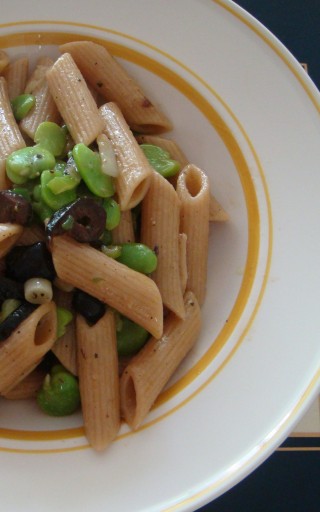 Charles and I ordered fava beans in Portugal two years ago, and we received a plate of them. There was a little dribble of very pungent olive oil on top, along with a few bits of hacked up raw garlic on the side. We had rented a car and driven up a mountainside on the country’s very southern tip. I got carsick, and Charles wandered off with an old lady on his arm, the car still running. I can’t drive standard. But the fava beans were very good.
Charles and I ordered fava beans in Portugal two years ago, and we received a plate of them. There was a little dribble of very pungent olive oil on top, along with a few bits of hacked up raw garlic on the side. We had rented a car and driven up a mountainside on the country’s very southern tip. I got carsick, and Charles wandered off with an old lady on his arm, the car still running. I can’t drive standard. But the fava beans were very good.
City slickers to the core, I guess, he had a scuff on his knee from having slipped down another mountainside en route to the beach the day before, and I was very sunburned, though perhaps not as badly as the English lobsters in our company. We padded around in shoes with leather soles for him (not so good for climbing) and a scarf with big sunglasses for me before stopping at this little restaurant nestled on a plateau in the middle of a steep hill. I fancied myself Jackie O, but probably looked more like a mummy instead. The waitstaff were very nice in any case.
We thought it was a little much, though, a plate mounded so many inches high with only fava beans. The dish was followed by the fish we ordered, which was really just a fish. The whole animal, cooked beautifully, but it didn’t seem that anyone had bothered to gut it, so we ate around the yucky bits, which were hard to see because the fish was swimming in a thick sauce of almonds and of cream. It also seemed a little much, but then we got stuck in three hours of traffic on the drive back. A bus had wedged itself behind a parked car, and no one in the town could find its owner. All two roads got clogged, so everybody waited. We were glad to have had the sustenance.
The town is called Sintra, by the way, though it may as well have been Macondo, and I cannot recommend it highly enough.
Penne with favas, oil-cured olives, pecorino
I don’t have as much time or patience as they do in Sintra, but fava beans are nice mixed with other things in addition to plain and just piled on a plate. Pairing them with pecorino (that is, a sheep’s milk cheese) is a classic of Italian cooking.
Fava beans, as many as you can stomach shelling | kosher salt + freshly ground pepper | pasta, ¼ lb per person | olive oil for cooking | spring onions or scallions, 1 or 2 per person | 1 big palmful oil-cured olives per person, pitted and chopped roughly | ½ lemon | pecorino or other sheep’s milk cheese or parmesan | best quality extra virgin olive oil for garnish, optional
Blanch the fava beans, which may be done ahead of time: Put a pot of water on to boil and salt it heavily. Shuck the fava beans. Toss in the beans, and wait for 2 minutes. Drain and rinse with cold water. When they are cool enough, slip off their tough skins. Or use frozen fava beans.
Put a pot of water on to boil and salt it heavily. Whenever the water is boiling, put the pasta in to cook.
While you are waiting, slice the spring onions and sauté them in a bit of olive oil over medium heat. Season with salt + pepper. Try not to let them brown. When they are a little wilted and transluscent, 3-5 minutes, toss in the favas and olives. Turn the heat to low, stir around, and let heat through for a few minutes to meld the flavors.
When the pasta is a minute shy of done, scoop out some of the cooking water with a mug, and drain the rest. Either add the pasta to the saucepan or the sauce to the pasta pan, along with a splash of that cooking water. Over low heat, stir around a bit. Squeeze over some lemon, and grate in some cheese. Stir around some more, taste, and add more pasta water, salt, pepper, or lemon as needed. Off heat, garnish with some fancy olive oil.
{ 2 comments… read them below or add one }
Oh, fava beans. A vegetable with a short season AND a time-consuming preparation. I think that makes them even more desirable.
! Shucking fava beans is such a quiet activity, though; you can do it while you’re on the phone! Makes the time fly. :)